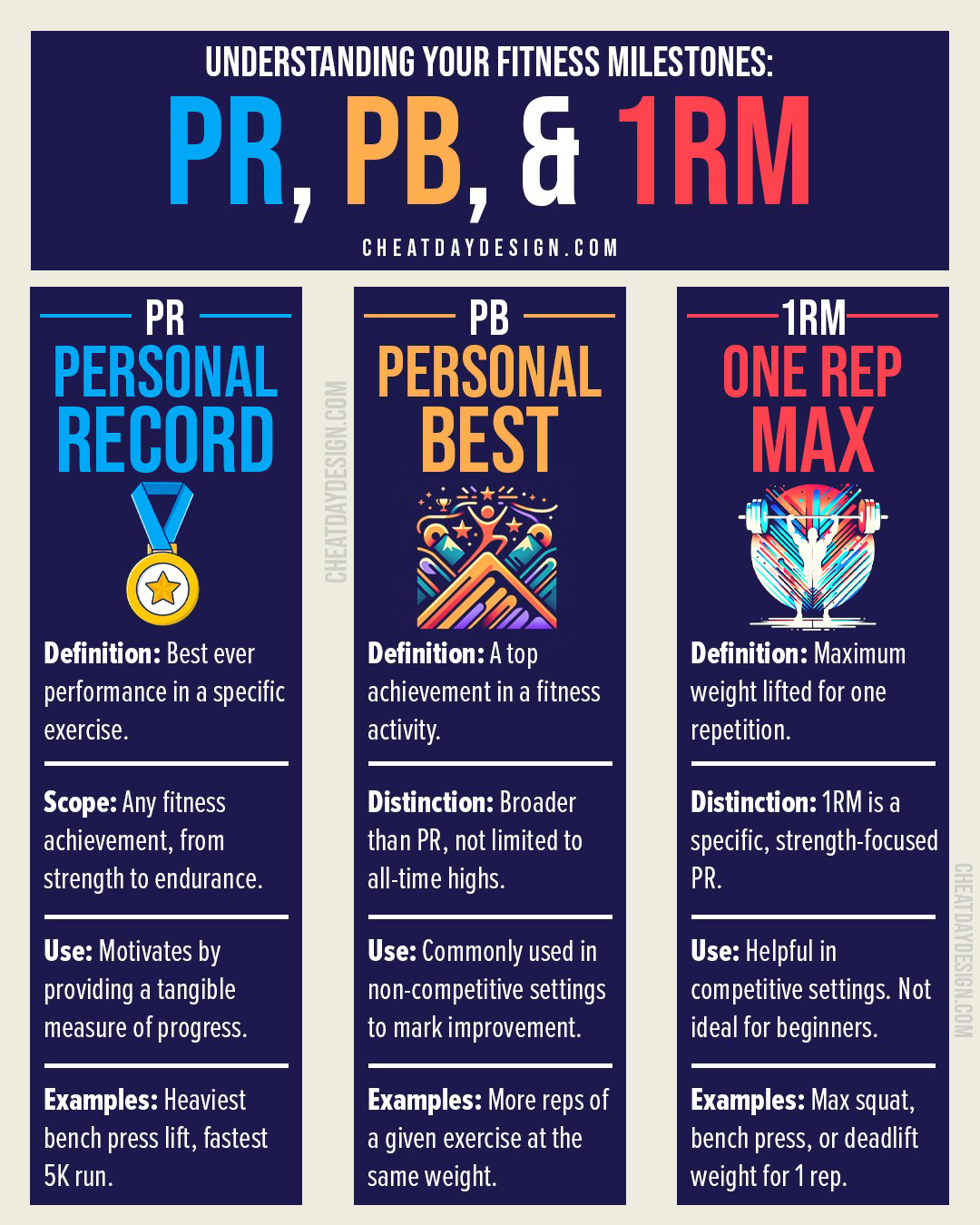Are you new to the fitness world and feeling confused by all the acronyms and terms thrown around in the gym? If you’ve heard people mention a PR or PB in the gym or on social media and have no idea what they mean, don’t worry, I’ve been in your shoes before and I’m here to help.



Highlights
- PR stands for Personal Record, indicating the best performance in a specific fitness activity. PB means Personal Best, also reflecting a top achievement.
- PR often denotes a specific, all-time achievement, like the heaviest weight lifted. PB can refer to any personal achievement (like getting more reps of a specific weight), not necessarily an all-time record.
- A 1RM (1 rep max) can be a Personal Record, but it’s not the only test of strength. If you increase the weight on an exercise and complete 5 reps, that is still a personal record.
In this post, I’m going to break down PRs and PBs and make it all make sense for you. But first things first, what do they stand for?
PR stands for a personal record, and PB stands for personal best.
These are often used interchangeably, and I’ll explain the differences below, but you’ll most commonly hear “PR” being used.
These terms are used commonly in the fitness world to celebrate progress, but they encompass more than just lifting heavy weights. A personal record can be any accomplishment in the gym, whether it’s running a certain distance without stopping or completing a specific exercise with more reps or heavier weight than before.
I’ll explain the different types of PRs, how to safely test your limits, and why it’s important to focus on your own progress rather than comparing yourself to others.
Let’s make your fitness journey way simpler.
What PR Means in the Gym
When we talk about PR in the fitness world, we’re referring to the term ‘personal record.’ It’s a term that marks your best performance in a given exercise.


For example, if you’ve pushed yourself to lift the heaviest weight you’ve ever managed on the bench press, that’s a PR.
It’s not just about strength training, though. A PR can also relate to endurance, like achieving a faster time on a 5k run or more overall volume for a workout.
It’s a highly personal measure of progress that’s unique to you and your fitness journey.
Think of a PR as a milestone that shows how far you’ve come and gives you a new baseline to test your progress against going forward. Whether you’re lifting weights, sprinting, or just starting your fitness journey, tracking your PRs is a powerful way to motivate yourself and see the tangible results of your efforts.
PB Vs PR: What’s the Difference?
The terms ‘personal best’ (PB) and ‘personal record’ (PR) are often used interchangeably in the gym, although they do carry slightly different meanings.
For simplicity’s sake, I recommend not worrying too much about the slight difference. Nobody will fault you for calling your achievements a PR or a PB.
But if you want to get down to the nitty-gritty, a personal best is a broad term that can refer to a wide range of achievements. In a lot of cases, people will refer to a “personal best” when they achieve more reps on a particular exercise than they have in the past.
On the other hand, a PR is often used to mark an all-time record, like the highest weight or the quickest time you’ve ever managed. In other words, PR tends to be a more specific achievement than PB.
For those competing, they’ll often refer to a “competition PR,” which is the heaviest weight they lifted specific to their competition. That may be entirely different from their gym PR, which could be even more weight that they lifted during a training session.



So, while all PRs are PBs, not all PBs are necessarily PRs.
For instance, you might have a session where you hit your PB for 10 reps of a certain weight, but it’s not the heaviest weight you’ve ever lifted for any number of reps—that would be your PR.
Understanding these nuances can help you better track your fitness progress and set appropriate goals.
A PR Is Not Just A One Rep Max
In the world of strength training, a PR can sometimes be confused with a one-rep max (1RM), but there’s a distinct difference that I want you to understand.
Your one-rep max is the maximum weight you can lift for one repetition of a specific exercise, such as a squat or bench press. It’s a measure of the most strength you can exert in a single effort.



A PR, while it can be your 1RM, isn’t limited to it. It encompasses any personal record set in your strength training.
If you previously achieved 5 reps of dumbbell shoulder presses, and then increased the weight by 5 pounds the following week and can complete 5 reps, that new weight is your PR.
You didn’t need to max out with a single repetition to see the progress made and record your new personal best.
In short, a 1RM is a specific type of PR that focuses on maximal strength (which is not for everyone- more on that in a minute), while PRs can represent a variety of achievements across different aspects of fitness.
Real life Examples of PRs
PRs come in various forms and are not limited to the amount of weight you can lift. We often think of them as the most weight you can lift, but that’s just one piece of the puzzle.
For instance, if you’re a runner, a PR could be shaving seconds off your best 5k time.



For someone focused on weight loss, a PR might be achieving a certain number of workouts in a week or reaching a new low on the scale.
In resistance training, apart from lifting the heaviest weight for one rep, completing a set number of reps at a particular weight can also be a PR—like finally hitting those 10 reps of squats with a heavier weight than you’ve used before.
Even outside traditional measures, PRs can be about consistency, such as maintaining a workout schedule over an extended period.
Each PR, no matter the size or scope, marks a step forward in your fitness journey and is a cause for celebration. PR’s are always worth recording and celebrating.
Tips For Safely Testing Your PR
Testing your PR, especially when it involves heavier weight, must be done safely to avoid injury. For beginners out there, I advise against testing your 1 rep max to measure your PR.
While maxing out on bench press or squats can be fun (and is something we always see shared on social media) there is simply no upside for beginners. If you aren’t completely comfortable with your form, something that comes with experience, then your form will break down while lifting weight that may be too heavy for your muscles to handle… that’s a recipe for disaster.
So, I recommend testing your PR with weight where you can achieve at least a few reps.



The first step with any PR is to ensure you have a proper warm-up routine that prepares your muscles and joints for the stress of a max effort. Incrementally increase the weight during your warm-up sets to gradually approach your target weight.
If you are a beginner, consider working with a personal trainer who can provide guidance and feedback on your form, too. When attempting a PR, having a spotter is wise, especially for exercises like the bench press or squat, where failure without support can be dangerous.
Additionally, listen to your body and understand the difference between pushing your limits and risking harm.
Lastly, ensure you’re well-rested and not fatigued from previous workouts because attempting a PR when you’re not at your best is setting yourself up for disappointment or injury.
The Danger of Comparing PRs
It’s human nature to look at others and see how we measure up, but when it comes to PRs, this comparison does far more harm than good.
Everyone’s fitness journey is unique, with different starting points, goals, and challenges. Comparing your PR to someone else’s can diminish your own achievements and potentially lead to demotivation, especially if you’re just starting out.
There’s also the risk of pushing yourself too hard to match someone else’s performance, which can result in injury.
It can be disheartening to feel like others are progressing faster than you, but that is just human nature. Trust me, I have been working out for over 15 years now, and in that time I have seen people with far less experience than me perform at a MUCH higher level than me.
Just because someone else is doing an amazing job and making great progress, that doesn’t mean that you aren’t.
It’s important to remember that PRs are personal benchmarks meant to track your own progress over time, not a leaderboard to compete against others. I mean, it’s called a personal record for a reason.
Celebrate your successes based on how far you’ve come and the effort you’ve put in. It doesn’t matter what anybody else is doing.
When Should You Record PRs?



When you’re starting out, literally everything is a PR, so how do you know what to record?
Frankly, it will never hurt to record too much, but you need to figure out what is most important to you.
Start by defining what success looks like for you, whether it’s weight loss, muscle gain, improved endurance, or simply a healthier lifestyle. Break down these larger goals into smaller, measurable milestones, like increasing your weekly running distance or adding weight to your lifts.
I recommend maintaining a workout log or using a fitness app to record your progress early on. That way, you won’t need to necessarily log your PR- it will all be right there for you.
Celebrate the small victories along the way, because they are the best motivation to keep you building towards your larger goals.
If you progress to a point where you are no longer logging every single workout, you’ll want to go by feel. If you’re feeling great with your workouts, dedicate one week to testing some new PRs (safely, of course).
One big mistake that a lot of beginners make is testing their PRs too often. My philosophy has always been this: build, build, build, test.
In other words, give yourself at least three weeks of workouts before you go out of your way to test a new PR (once per month, at most).
PR & PB: Valuable Tools For Your Fitness Journey



PRs are more than just numbers on the weights; they’re a reflection of your commitment to your fitness journey. They serve as a tool to challenge yourself, set benchmarks, and celebrate the small victories.
The real value of a PR lies in what it represents—the hard work, consistency, and dedication you’ve invested in yourself. It’s about overcoming personal barriers and setting new standards for yourself.
Remember, every time you hit a PR, it’s a step forward in your journey, no matter how small it may seem. Let your PRs motivate and inspire you, but don’t let them define you.
Fitness is a lifelong journey, and PRs are simply milestones along the way.





